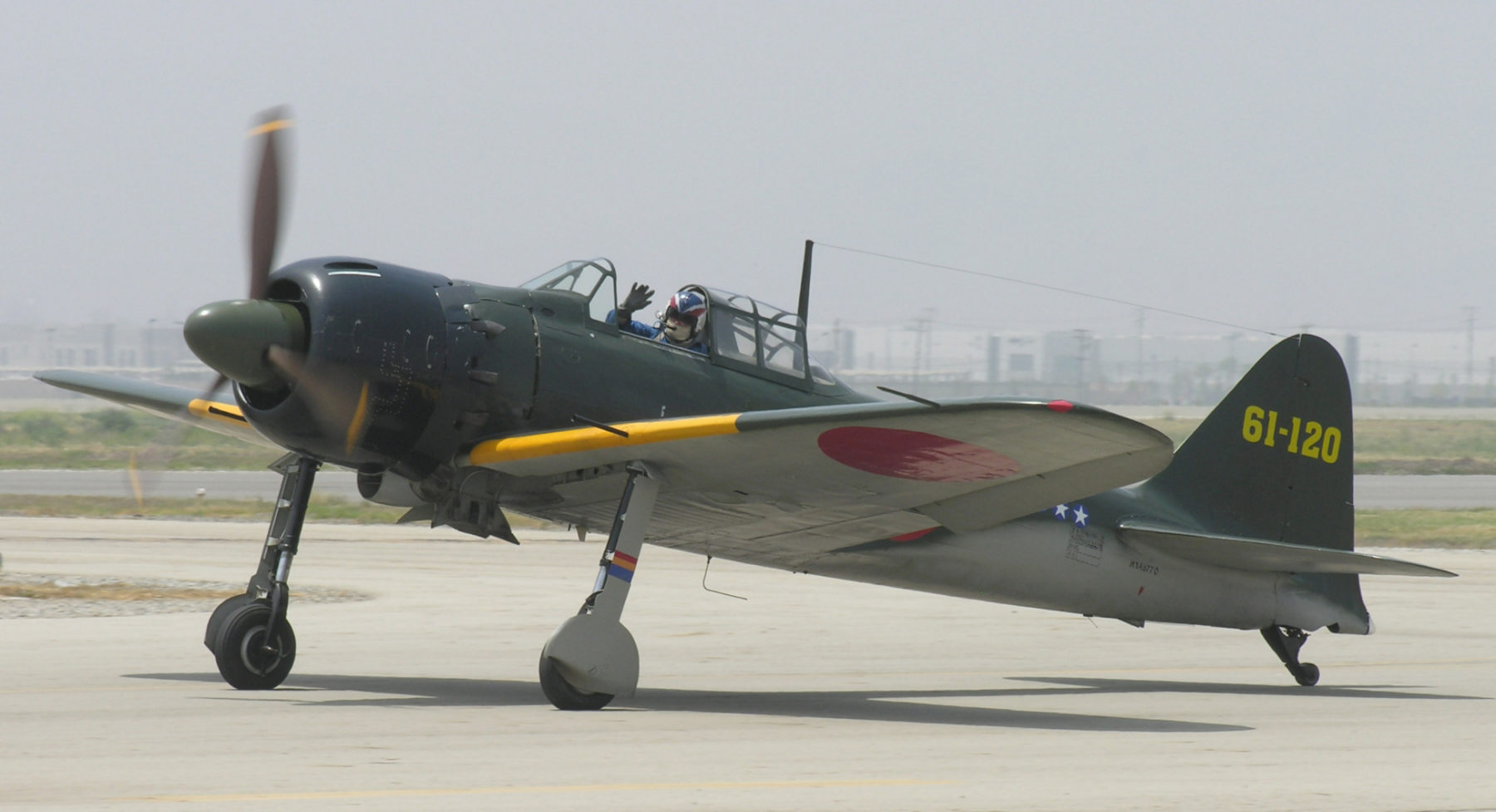
Interwar and WW2 Imperial Japanese Aviation
 Japan, 1919-45. 5000+ Aircraft
Japan, 1919-45. 5000+ Aircraft
Land/Carrier based IJN aircraft:
 Articles (so far)
Articles (so far)
- Aichi D1A "Susie" (1934)
- Mitsubishi A5M "Claude" (1935)
- Nakajima A4N (1935)
- Yokosuka B4Y "Jean" (1935)
- Mitsubishi G3M "Nell" (1935)
- Nakajima E8N "Dave" (1935)
- Kawanishi E7K "Alf" (1935)
- Nakajima B5N "Kate" (1937)
- Kawanishi H6K "Mavis" (1938)
- Aichi D3A "Val" (1940)
- Mitsubishi A6M "zeke" (1940)
- Nakajima E14Y "Glen" (1941)
- Nakajima B6N "Jill" (1941)
- Mitsubishi F1M "pete" (1941)
- Aichi E13A Reisu "Jake" (1941)
- Kawanishi E15K Shiun "Norm" (1941)
- Nakajima C6N Saiun "Myrt" (1942)
- Yokosuka D4Y "Judy" (1942)
IJN Fighters:
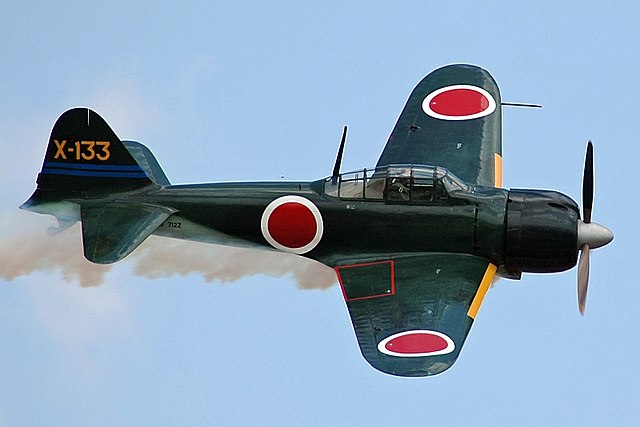 Without contest, the A6M was the most famous IJN fighter in 1941. Agile, fast, with a long range and top-tier pilots, it brushed aside all opposition until late-1942 when the Hellcat and Lightning started to be introduced. Its army equivalent was the equally agile Nakajima Ki-43 "Oscar".
Without contest, the A6M was the most famous IJN fighter in 1941. Agile, fast, with a long range and top-tier pilots, it brushed aside all opposition until late-1942 when the Hellcat and Lightning started to be introduced. Its army equivalent was the equally agile Nakajima Ki-43 "Oscar".In the long rivalry between services, the IJN won the match for arguably the best Japanese fighter ever, in the shape of the A6M, and Mitsubishi became the naval fighter specialist in Japan. This went full circle between the 1MF1, first IJN fighter built in Japan, the A5M in 1935 and the famous A6M in 1940. In between, Nakajima provided, as well as Kawasaki and Aichi. The IJN also tested the Dewoitine D.510J in 1936, the Canadian Car & Foundry AXG1 in 1938, Heinkel A7He1 (12), the same year, the American Douglas HXD and Fairchild LXF1, even an operational unit of Seversky A8V fighters.
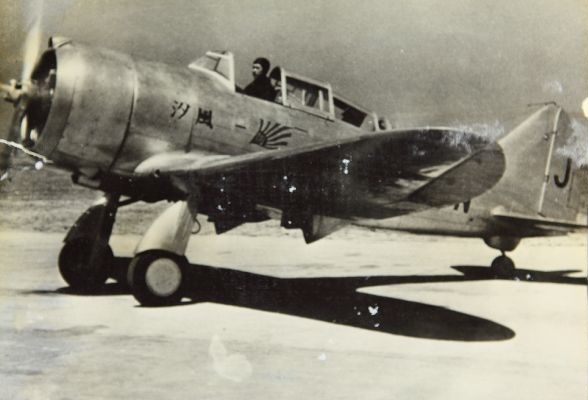
Seversky A8V (1938) used as propaganda plane from the newspaper Asahi Shimbun, named Shiokaze-go and Umikaze-go. They operated in a single unit in China, the 12th Kōkūtai, operating from bases around Nanking. It received the USN Intel name of A8V1 "Dick", the Japanese designation for the 2PA-B3, but little is known about its fate.
Mitsubishi 1MF1 (1921)
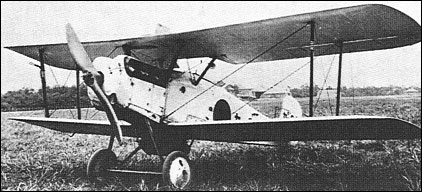
The Mitsubishi 1MF was the first IJN fighter, deployed on the carrier Hosho, 138 built, retired around 1923.
Gloster Sparrowhawk Is (1921)
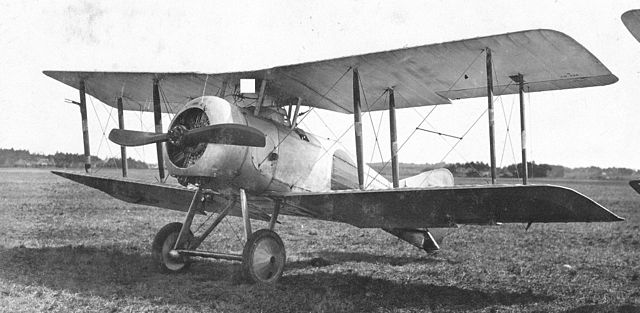
The Imperial Japanese Navy also used the Gloster Sparrowhawk, directly purchased, from 1921. 90 were in service until 1928.
Designed by Henry Folland based on the Nieuport Nighthawk, it first flew in 1921, and was derived into the Gloster Grouse in UK. It was was made from existing stocks of stored Nighthawk components, initially propelled by a Dragonfly engine. However instead, the new Sparrowhawk was propelled by a Bentley BR2 rotary engine from Gloster, which allowed Japan to order for 50 of these from the Gloster Factory while the next 40 would be assembled from knocked-down kits by Yokosuka Naval Air Technical Arsenal. 30 were Sparrowhawk I land based fighters, ten Sparrowhawk II twin-seat advanced trainers and the rest, Sparrowhawk III shipboard fighters. The latter were really close to the 22 Gloster Nightjar carrier fighters in the Royal Navy and had a flotation equipment and arrestor gear. Yokosuka's planes were called Is.
Quickspecs:
5.99 x 8.51 m x 3.20 m, 1,850/2,165 lb (982 kg), Bentley BR2 9-cyl. AC rotary 230 hp (170 kW), 2-bladed FP prop.
125 mph (201 km/h, 109 kn) at sea level, 3 hours endurance, ceiling 16,900 ft (5,200 m).
Aichi Type H
This was the imported German Heinkel HD 23, produced under licence by Aichi Type H (1926) for studies. It was a semi experimental fighter of which just four were built.Kawanishi K-11 (1927)
The Kawanishi K-11 was an experimental fighter, 2 builtNakajima A1N (1928)
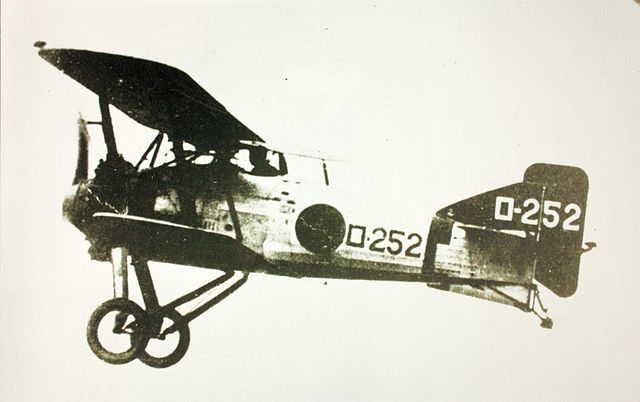
The Nakajima A1N was based on the imported Gloster Gambet, and 151 were built. It was retired in 1935.
Nakajima A2N (1929)
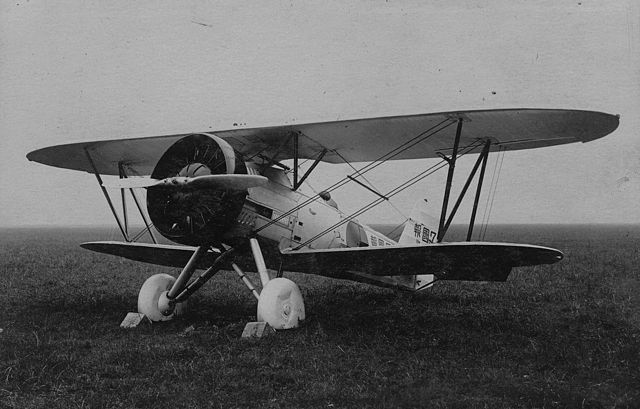
166 of these were built, retired in 1941.
Mitsubishi A5M (1935)
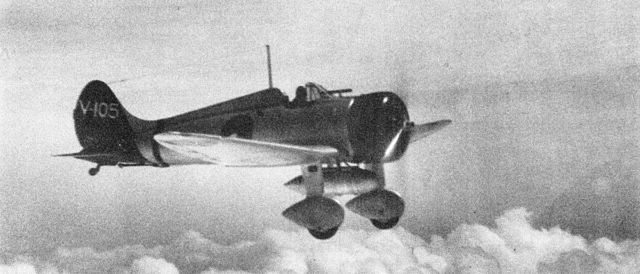
The Mitsubishi A5M was the first main fixed-train monoplane fighter of the IJN, and 1094 were built. It made the bulk of carrier groups in 1939, and even until 1941, gradually replaced until December by its successor. But it was kept in China, or isolated point-defence, and was only really retired in 1945.
Nakajima A4N (1935)
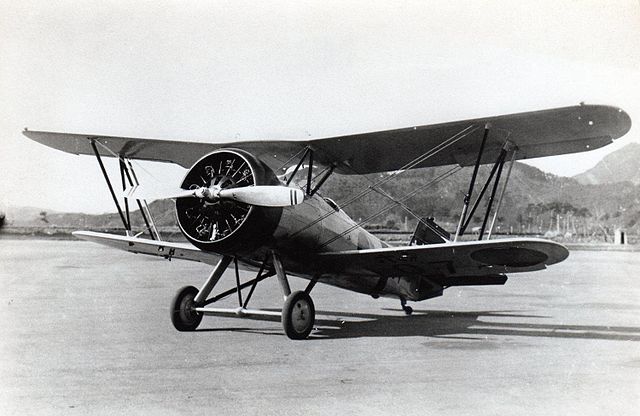
Of the same generation was the Nakajima A4N biplane, which first flew in Autumn 1934 but was introduction from January 1936, as a land and carrier-based fighter, produced from 1935 to 1940 with 221 built. Many were still around in 1941, like the "Claude" in China or point-base defense across the Pacific. Second line 1942, it was replaced in December 1941 by the A6M on carriers, and fully retired in 1943.
Mitsubishi A6M Zero "Zeke" (1939)
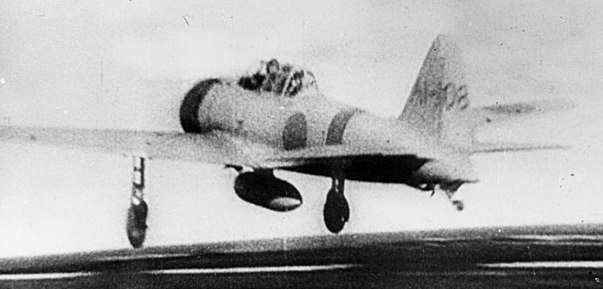
The Mitsubishi A6M Zero was by By far the most famous navy fighter. 10,939 built in many variants during the war. In December 1941, all carriers of the Kido Butai had received it, and pilots already had some training, after their transition from the A5M. We can dive deep into the plane and the myths surrounding it, but it will be the object of a fully fledged post.
Nakajima J1N Gekko "Irving" (1941)
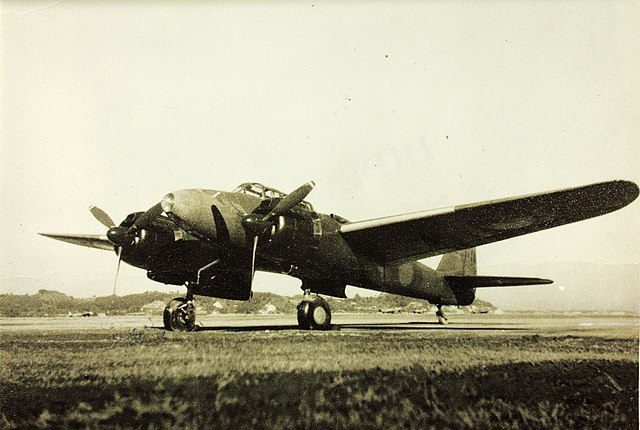
The Nakajima J1N Gekko was the main land-based fast twin-engine heavy fighter of the IJN. With 479 built it was easily eclipsed by the Zero but proved its worth for escorting land-based bombers especially in the early stage of the Pacific campaign.
Mitsubishi J2M Raiden "Jack" (1942)

The Mitsubishi J2M Raiden "Jack" was not the successor of the A6M, but a land-based high altitude interceptor, much more powerful, faster and armoured. It was however complex and produced in short quantities at that stage on the war (621 built) due to strategic materials shortages. Most saw action in the home islands, against USAAF formations or carrier borne air raids.
Kawanishi N1K-J Shiden "Georges" (1943)

The Kawanishi N1K-J Shiden was a good fighter born from a floatplane, which was rare. It looked like the Kawasaki Ki-100 but it was more powerful, sturdier and better armed than any previous design and arguably the best fighter ever made by Kawanishi, the great Japanese floatplane/seaplane specialist. Derived from the "Rex" floatplane fighter, around 1400 were built, which mostly saw action in the home island in the last stage of the Pacific campaign.
Mitsubishi A7M Reppū "Sam" (1944)
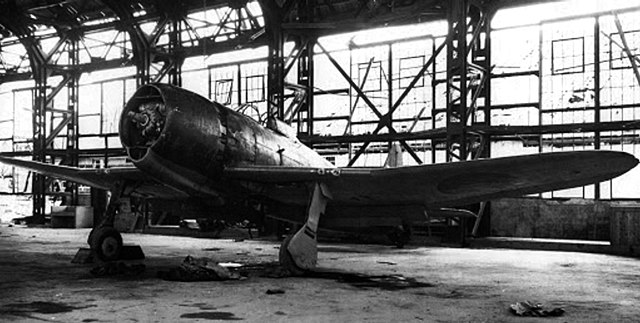
The Mitsubishi A7M Reppū was the nominated true replacement for the A6M "zeke", drawing on improvements left and right, from the J2M and N1K. Only 10 preserie were ever built, it never really entered service in time.
Yokosuka MXY-8 Akigusa (1945)
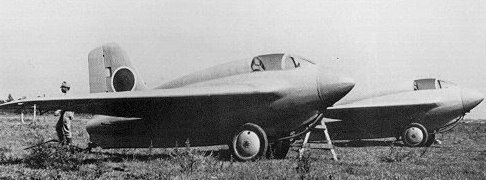
This was a clone of the German Me 163 Komet, which plans and parts arrived via U-Boat. About 50-60 were built but apparently never used.
Carrier-borne Bombers

-Aichi D1A (1934) dive bomber, 590 built codename "Susie"
-Aichi D3A (1938), main IJN dive bomber, 1,486 built
-Yokosuka D4Y (1942) codename "Judy" diver bomber, 2,038 built
Navy land-based Torpedo Bombers
-Mitsubishi G3M (1935), 1,048 built, long range twin engine navy land-based bomber, codename "Nell".-Mitsubishi G4M (1939) "Betty", Main long range twin engine torpedo bomber of the navy, 2,435 built
-Nakajima G5N Shinzan (1941) "liz" long-range quad-engine heavy bomber, 6 built
-The navy also experimented with the Mitsubishi Ki-67 bomber, with a torpedo-bomber, the "Yasukuni", and a dedicated ASW plane, the Mitsubishi Q2M1 Taiyo.
-Nakajima B6N Tenzan (1941) coldename "Jill", 1,268 built planned replacement for the "Nate".
-Aichi B7A Ryusei "Jack" (1942), last IJN carrier-borne Torpedo bomber, 114 built
Torpedo-bombers
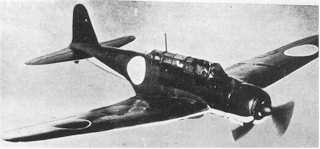
-Mitsubishi 1MT (1922), triplane 20 built retired 1928.
-Mitsubishi B1M (1923), 443 built, retired 1936.
-Mitsubishi B2M (1932) 206 built, based on Blackburn Ripon, retired 1939-1940
-Yokosuka B4Y (1935) 205 built, biplane, retired 1943
-Mitsubishi B5M (1936) fixed carriage monoplan bomber, 125 built
-Nakajima B5N (1937) 1,150 built, main torpedo bomber
-Yokosuka P1Y1 Ginga "Frances" (1943) Navy Land-Based twin engines Bomber, 1098 built
Misc.
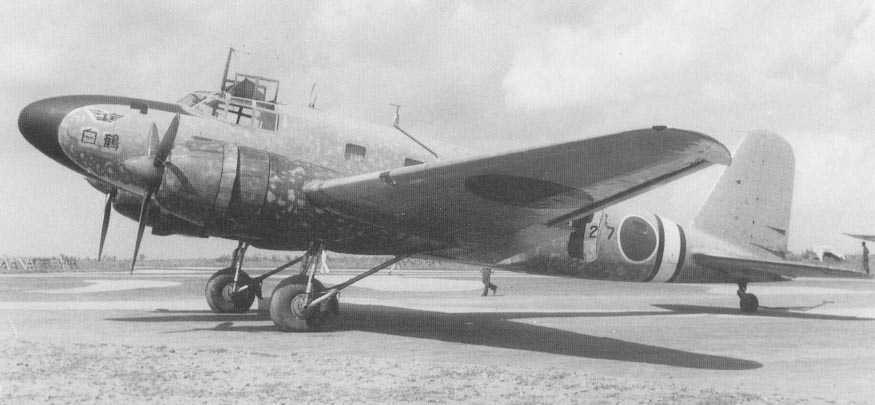
Mitsubishi MC-20-II, close to the L4M, Naval transport plane
-Yokosuka K2Y (1929), main navy trainer based on Avro 504, rarely mounted on floats. All 464 built were used by the Navy.
-Nakajima C2N (1930) staff carrier developed with Fokker, used by the navy and army (Ki-6), prod. unknown
-Mitsubishi K3M (1930), navy trainer and liaison, recce, 625 built, retired 1940s
-Mitsubishi 2MR (1932), carrier-based recce biplane, 159 built, retired 1937-38 as trainers
-Yokosuka K5Y (1934) 5,770 main IJN biplane trainer, with undercarriage or floats, used during WW2
-Hiro G2H (1933) 8 long-range recce/bomber land-based biplanes, most destroyed at Cheju Island in 1937
-Gasuden KR-2 (1934), light transport biplane, small prod.
-Nakajima C3N (1936) experimental recce monoplane with fixed undercarriage
-Nakajima L1N (1936) main transport monoplane twin engine, 351 built
-Mitsubishi L4M (1939) main twin-engine transport plane, 406 built
-Nakajima/Showa L2D (1939) large navy transport plane codenamed "Tabby", DC-3 copy.
-In 1939 also first flew the Nakajima LXD-1, transport four-engined prototype.
-Kyushu K9W1 Momiji (1942) biplane trainer based on the Bücker Bu-131, 339 built
-Kyushu K11W1 Shiragiku (1942) monoplane advanced operations trainer, 798 built
-Nakajima C6N Saiun "Myrt" (1943) Navy Carrier Reconnaissance Plane, the fastest built by Japan, 463 built.
-Yokosuka MXY-7 Ohka (1944) codename "Baka" the famous suicide rocket plane, 852 built
IJN Naval Planes:
Design and operation
However in WW2 the largest man-made flying objects, after lighter-than air dirigibles, were flying boats.This bring us to some explanation on the triple denomination:
-"Floatplanes" are optional land planes with floats, generally a central one and two smaller ones under the wings, or two large. They are otherwise similar to their land-based cousins, and generally shipboard.
-"Seaplanes" are fully waterproof and are given a ship's underbelly to land and take off from water.
-"Flying boats" are generally considered the same, but earning a connotation of larger size.
The latter disappeared from the aviation lexicon in the early 1960s, killed by passenger jets.
But in WW2 they were the largest flying vehicles around. The record went to the German Blohm & Voss BV 238, a 54 tonnes light behemoth, 45m long for a 60m wingspan, transport flying boat, and built by a naval yard. The Japanese Kawanishi "Emily" was the largest on offer.

Author's illustration of the Kawinishi N8K-2 "Emily".
While on the other side of the Atlantic, U-Boats met their "happy times" along the US coast. Alongside massive construction plans for new escort vessels and Liberty-ships, the eccentric aviator/tycoon Howard Hugues came out with an idea, in association with Henry J. Kaiser yards (Liberty-ships and "jeep carriers"): Mass-producing a giant flying boat, basically a flying Liberty ship. The project was approved but accumulated delays and ultimately was completed in 1947.
By that time there was a senate enquiry about funds allocated to Hugues's projects. The Hughes H-4 Hercules never entered service and became a multiple records breaker after its one and only short flight. It was saved in the Smithonian Museum after a while. The "spruce goose" was only partially bested by land planes such as Galaxy C-5 or Antonov 225. In the Pacific meantime, the USN submarine fleet was breaking the back of Japanese shipping and many islands scattered across the pacific became short of supplies and reinforcements. Between a cargo ship, slow and vulnerable, and a cramped, slower transport sub, the flying-boat solution was seductive.
There is no evidence Japanese intelligence ever had the knowledge of Howard Hugue's infamous "spruce goose", but the IJN really needed to carry goods all across its newly-acquired Pacific empire, fast and safely, and at a time things were still balanced for the IJA. So the Navy wanted its flying boat, not for reconnaissance or ASW but purely for transport. It was a supply/troops carrier however, no serious engineer would have considered lifting tanks with this plane. Until then, smaller H6K "Mavis" and H8K "Emily" were the only available, in short supply and lacking range for such a task.
Recce/multirole seaplanes
Yokosuka E1Y (1926)
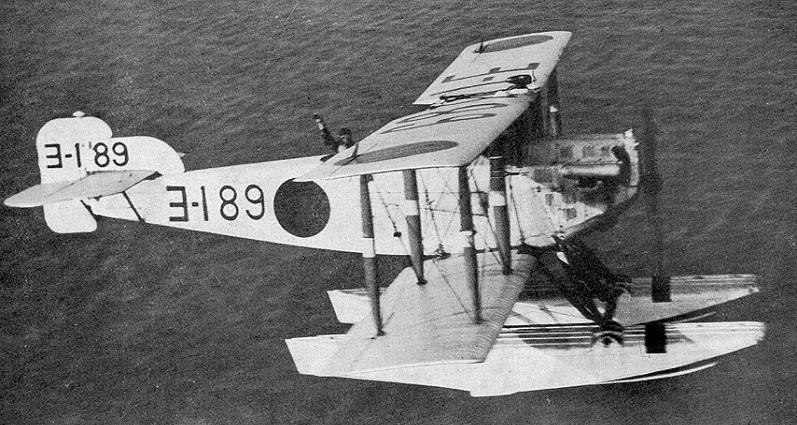
-Yokosuka E1Y 1926 reconnaissance seaplane >
Nakajima E2N (1929)
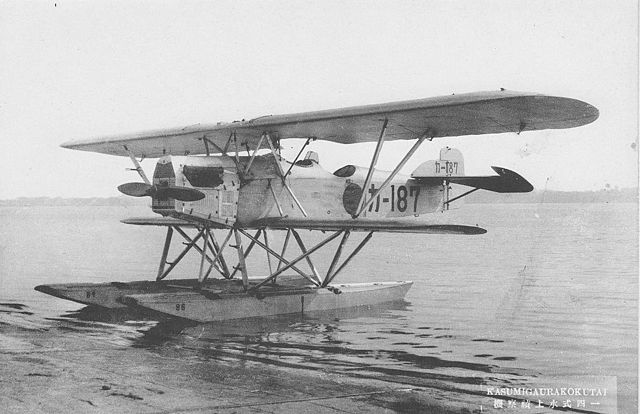
-Nakajima E2N 1929 reconnaissance seaplane >
Nakajima E4N (1930)

-Nakajima E4N 1930 reconnaissance seaplane >
Kawanishi E7K (1932)
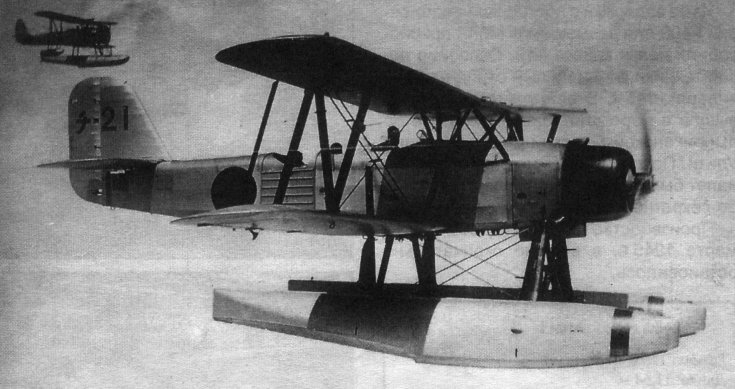
-Kawanishi E7K >
Nakajima E8N "Dave" (1932)
-Nakajima E8N "Dave" >Mitsubishi F1M "pete" (1969)
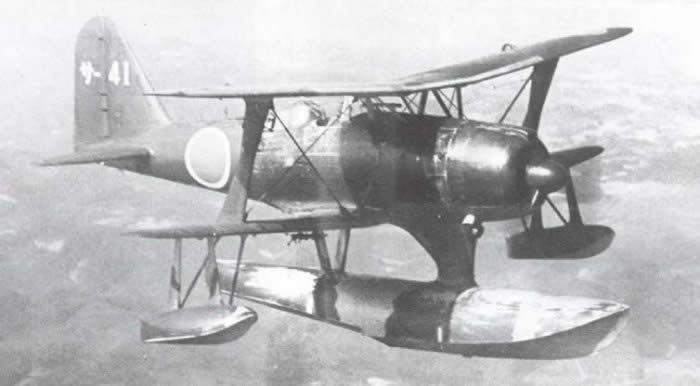
-Mitsubishi F1M "pete" >
Aichi E13A "pete" (1940)
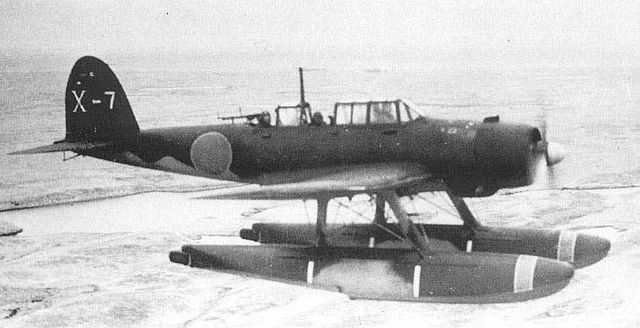
-Aichi E13A >
Aichi E16A "Zuiun" (1943)
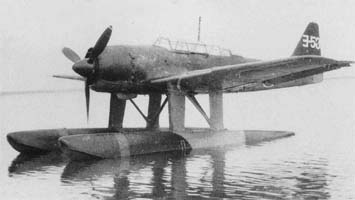
-Aichi E16A 'Zuiun' >
Floatplanes & seaplanes
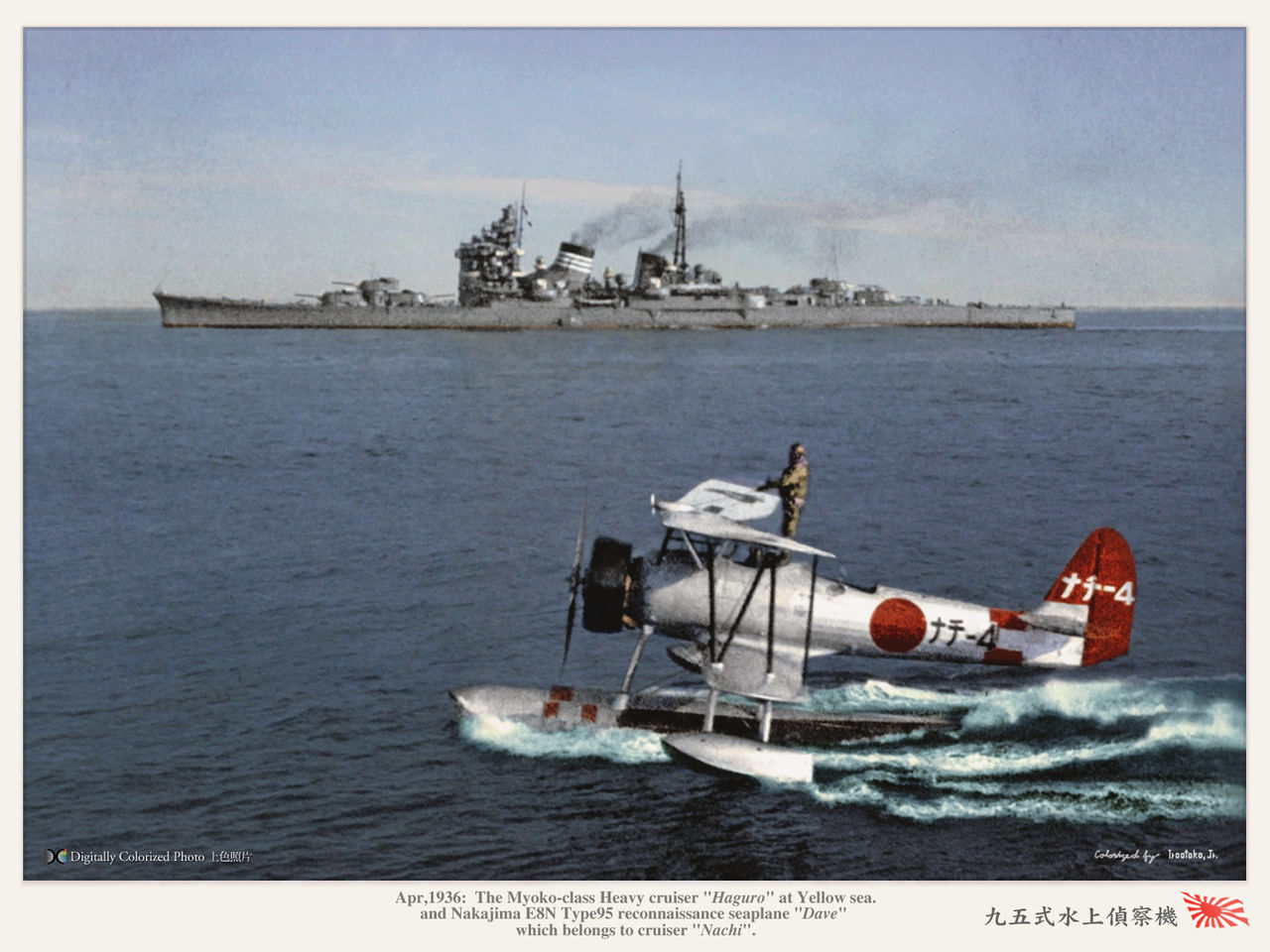
IJN Haguro and IJN Nachi's Nakajima E8N (Type 95) "Nate" recce plane - colorized bi Iroo Toko Jr.
Yokosuka K1Y (1925)
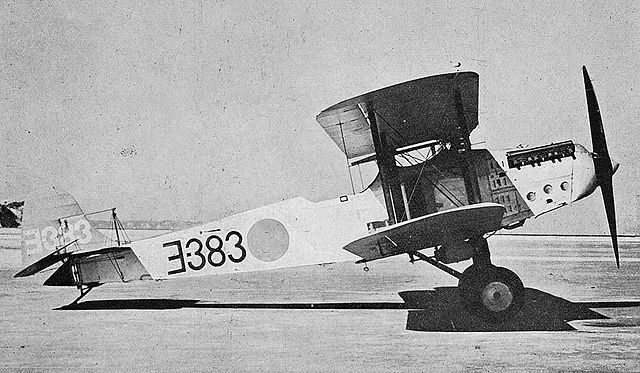
Main trainer/spotted floatplane of the Navy, 104 built, retired 1941
Hiro H1H (1925)

This was a reconnaissance and ASW patrol seaplane, of which 60 were built. It was retired in 1938.
Aichi Type 15-Ko Mi-go (1925)
A semi-experimental seaplane, of which 4-5 were built, operational service.Yokosuka E1Y (1926)

This was the main onboard reconnaissance floatplane of the IJN, with 320 built, retired in 1938
Aichi Navy Type 2 (1928)
An experimental floatplaneNakajima E2N (1929)

The Nakajima E2N was a 2 seat recce biplane floatplane, 80 built, retired in the late 1930s
Yokosuka E6Y (1929)
A submarine-based reconnaissance and attack floatplane, of which 10 were built, retired in 1943Yokosuka K4Y (1930)

A main IJN trainer and reconnaissance floatplane, with 211 built, retired 1940s.
Yokosuka E5Y (1930)
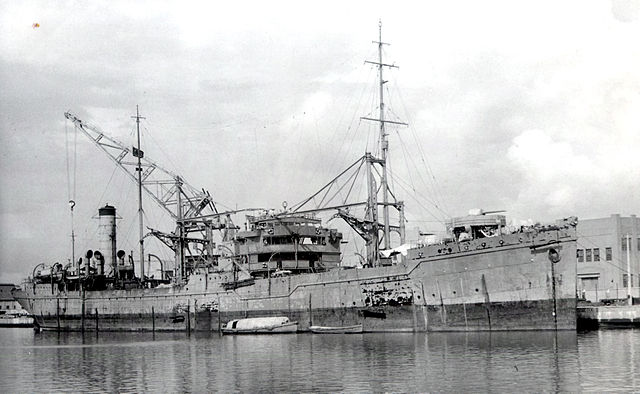
A reconnaissance floatplane used onboard IJN NOTORO, phased out in the late 1930s, of which 20 were built.
Aichi E3A (1930)
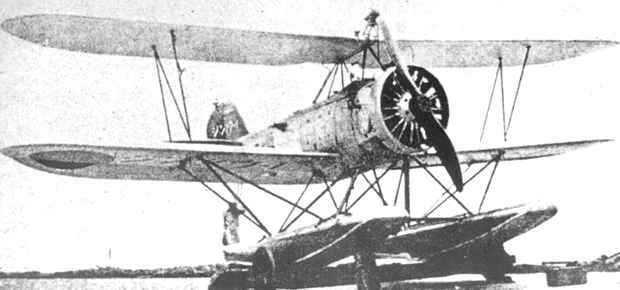
Reconnaissance floatplane developed with the German company Heinkel of which 20 were built
Nakajima E4N (1930)

A Japanese reconnaissance floatplane of which 153 were built, retired in the late 1930s
Hiro H4H (1933)
A reconnaissance seaplane of which 47 were built, which was retired 1940Kawanishi E7K (1934)

The main reconnaissance onboard floatplane of the IJN from 1935, widespread with 533 built on cruisers and battleships, served in WW2 in first and second line.
Nakajima E8N "Pete" (1935)
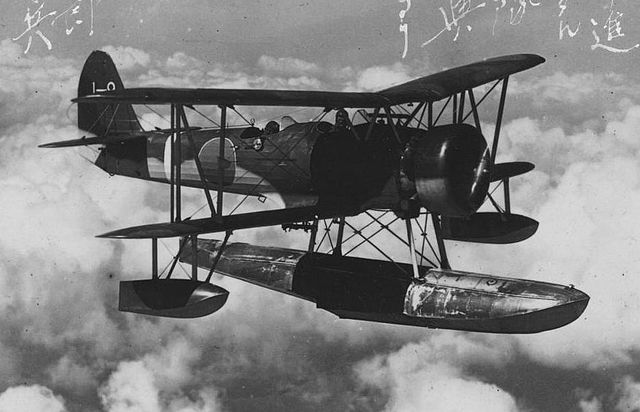
Second Main reconnaissance floatplane in service as a biplane during ww2, 755 built
Kawanishi E10K (1934)
An experimental transport and reconnaissance floatplaneKawanishi H6K (1936)

A Four engine flying boat of which 215 were built.
Mitsubishi F1M "Pete" (1936)

Main IJN Reconnaissance floatplane, 944 built. The last biplane floatplane of the IJN, discarded in 1944-45, used in many islands.
Yokosuka H5Y (1936)
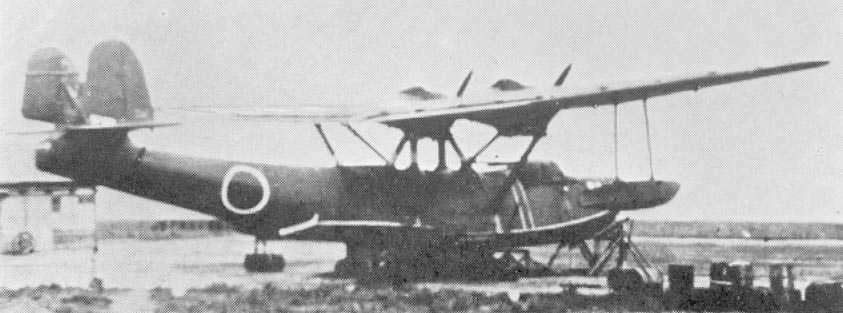
The Type 99 Flying Boat Model 11, also called in the Navy Yokosuka H5Y. 20 were built. The H5Y was designed by Yokosuka based on IJNAS requirement for a twin-engine maritime reconnaissance flying boat. It was to be faster than contemporary four-engine flying boats but cheaper and easier to maintain. Two prototypes were built by the 11th Naval Arsenal in Hiro. Completed in 1936, they had a twin-engine parasol configuration and resembled the previous Kawanishi H6K "Mavis". Poor performances and structural problems delayed production. production ended in 1941 at the Dai-Juichi Kaigun Kokusho facility. Also called the Type 99 Flying Boat Model 11, it was accepted in service in 1939 but the order was later cancelled. They were used for coastal anti-submarine patrols until 1942 and then transferred to the second line. They were used as transport and for training.
Specs:
20.53 x 31.57 x 6.71 m; 7,070/11,500 kgs, crew 6.
Two Mitsubishi MK1A Shinten 21 (14-cyl. AC Radial 890 kW (1,200 hp), 3-bladed VP props
Top speed 306 km/h, 700 m, 4,800 km or 26 hours ceiling 5,200 m, altitude: 3,000 m/24 min.
Armed with 3× 7.7 mm MGs, two 250 kg (552 lb) bombs
Watanabe K8W (1937)

Trainer and reconnaissance floatplane. In 1937, the IJN drew specifications for a 12-shi primary floatplane trainer. It was to replace the Yokosuka K4Y (Navy Type 90), Kawanishi, Watanabe and Nihon Hikoki ("Nippi") were contacted. Gasuden Jimpu radial engine (K4Y) was asked for and Watanabe's design (K8W1) of a single-engine biplane with a fabric-covered steel-tube fuselage and a wooden wing two floats was judged inferior. The first prototype flew in 1938, then two modified ones but production was not ordered.
Aichi E11A "Laura" (1937)
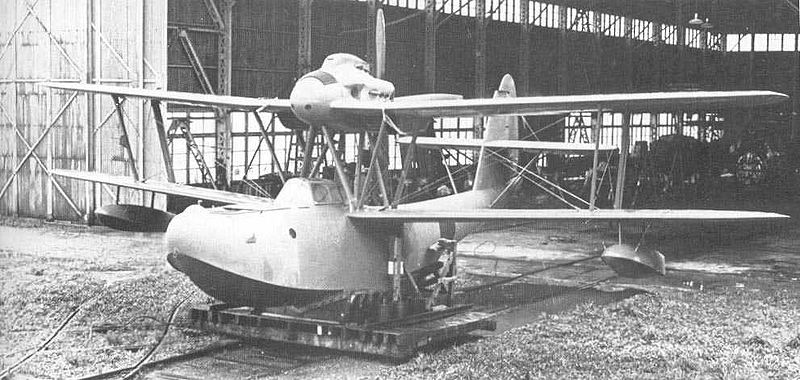
Only 17 of these gunnery spotting seaplanes (E11A Type 98) were produced and delivered that year. They served for the whole of WW2. Called Kyū-hachi Yatei these flying boats biplanes were used in 1939 for maritime patrol duties. It was also known as the Type 98 Reconnaissance Seaplane. It was similar to the E10A (Type 96) "Hank" but rarer. Designed as an onboard model in cruisers or battleships as night spotters, it was diverted to secondary duties, communications and transport.
Specs
10.71 x 14.49 x 4.52 m; 1,927 kg/3,297/3,297 kg, Crew: 3
Hiro Type 91 Model 22 W-12 wc 460 kW (620 hp), 4-bladed FP pusher prop
Top speed 217 km/h, Range 1,945 km, ceiling: 4,425 m
Armament one 7.7 mm (.303 in) Type 92 MG
Kawanishi E11K (1937)

Two of these transport flying boats were built. Requirement dated back from 1936, replacing the Aichi Type 96 Seaplane, as specialised night reconnaissance aircraft. It was also meant to shadow enemy forces at night and direct submarines. Aichi and Kawanishi producing accepted prototypes, but not Kawanishi. The latter was a gull winged cantilever monoplane powered a pusher Hiro Type 91 w engine. It was strut mounted above the wing and had a four-bladed propeller, and faired radiator aft. It had retractable wingtip floats, and was meant to serve onboard cruisers.
The first prototype 11-Shi Special Reconnaissance Seaplane (E11K) flew on 11 June 1937 but proved to have poor stability and a poor seabot, with its engine installation overheating. A second model was proposed after modifications but rejected. Both served as utility transport aircrafts, reclassed as Type 96 Transport, used for liaisons in reconnaissance seaplane squadrons.
Nakajima E12N (1938)
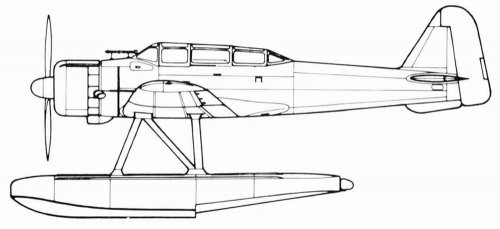
Two reconnaissance floatplane were built and delivered. In the fall of 1937, a competition to develop a two-seater reconnaissance seaplane onboard cruisers or capital ships was answered by Aichi with its E12A and Nakajima with its E12N, finally Kawanishi had its E12K project. Nakajima's model was designed by Shinroku Inue as a two-tier, low-plane, and all-metal model with trapezoidal wing. It had flaps increasing lift when catapult launched. It was fitted with a Mitsubishi MK2A Zuisei 11 (Ha-31-11) engine of 850 hp. It was armed with two fixed 7.7-mm bow MGs and one defensive in turret at the rear. It could carry also a single 250-kg or two 60-kg bombs under the fuselage. Requirements changed in 1937 and it was modified to accept a crew of three and its range was increased significantly. The final two prototypes were demonstrated in 1938, showing better than the E12A. The fleet preferred the three-seater, chossing the E13A as a constructive development of the E12A.
Nippi K8Ni1 (1938)
A trainer floatplane, only two built.Watanabe E9W (1938)

35 of these shipboard reconnaissance biplanes were built and delivered
Watanabe K8W (1938)
Only three of these reconnaissance seaplane trainers were built.Aichi E13A (1938)

The main reconnaissance monoplane floatplane on board all IJN cruisers and capital ships in WW2, 1,418 built, 1st line until the end of the war. Standalone post awaited.
Kawanishi E13K (1938)

Two prototypes, 3-seat ship-borne reconnaissance monoplane. In 1937 the spec asked Kawanishi and Aichi to design a replacement for the E7K. Kawanishi's Navy 12-Shi Three-seat Reconnaissance Seaplane, was all-metal, single-float defended by a Type 92 MG and carrying a bomb under its fuselage/4 under wings. First flight on 28 September 1938. Operational tests in October 1938 at fleet base. The team tought it was superior to the Aichi E13A. But it appeared slower and more difficult to operate and was rejected.
Kawanishi K6K (1938)

Sseaplane trainer, three were delivered for service. The K6K was a 2-seat twin-float biplane which fuselage was a welded steel-tube frame. It was covered in fabric and was made of light alloy and steel. Its wing was covered in fabric. It also had monocoque floats in light alloy. It answered the requirement for a intermediate-level training seaplane and first flew on 30 April 1938, showing poor performances. It was rejected for production.
Kawanishi K8K (1938)
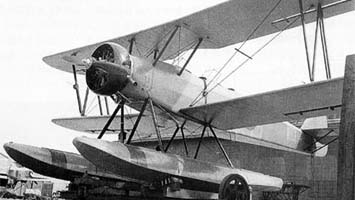
Seaplane trainer, 15 built.
In 1937, this model followed a specification for a 12-shi primary floatplane trainer and replacement for a Yokosuka K4Y. Kawanishi, Watanabe and Nihon Hikoki ("Nippi") were contacted. They were to use the Gasuden Jimpu radial engine of the K4Y. Kawanishi's K8K1, was a single-engine biplane, with a steel-tube fuselage covered in fabric and wooden wing, two floats. Both trainee and instructor had individual open cockpits. Three prototypes were made, the first on 6 July 1938. Nippi K8Ni was disqualified and the K8K was selected over the Watanabe K8W. In production it becaùe the Navy Type 0 Primary Seaplane Trainer. In addition to the two prototypes, 12 production models were built, but terminated as the Navy opted for the Yokosuka K5Y.
Nippi K8Ni1 (1938)
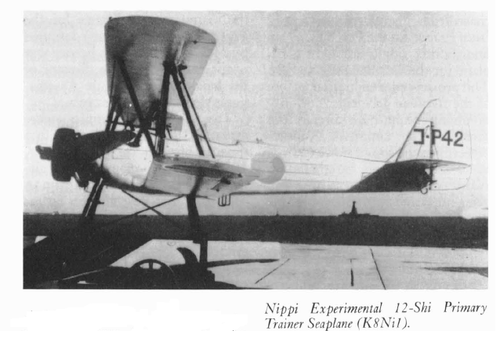
Seaplane trainer prototype, few info available
Nakajima E12N (1938)
Reconnaissance floatplane, only 2 builtAichi H9A (1940)
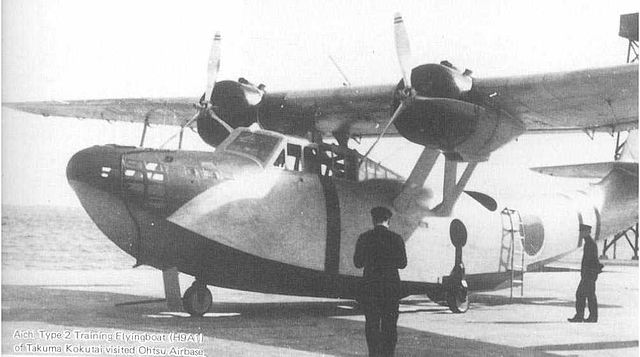
Reconnaissance seaplane, 31 only built (Alternative to the E13A)
Nakajima E14Y (1939)
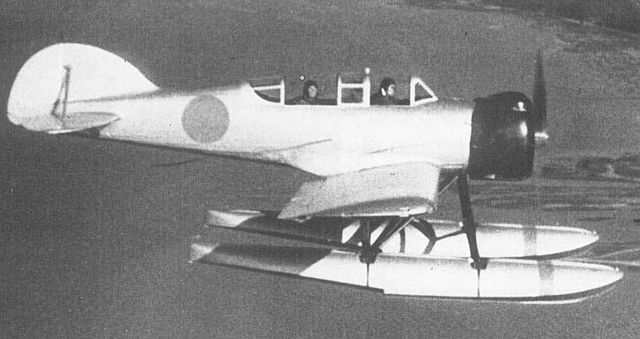
A shipboard reconnaissance floatplane of which 126 were built and delivered
Kawanishi E15K Shiun "Norm" (1941)
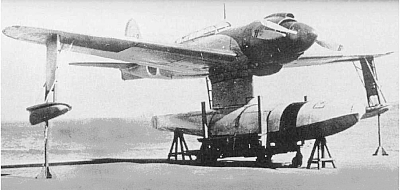
15 only were built of this floatplane Torpedo bomber.
Kawanishi H8K "Emily" (1941)
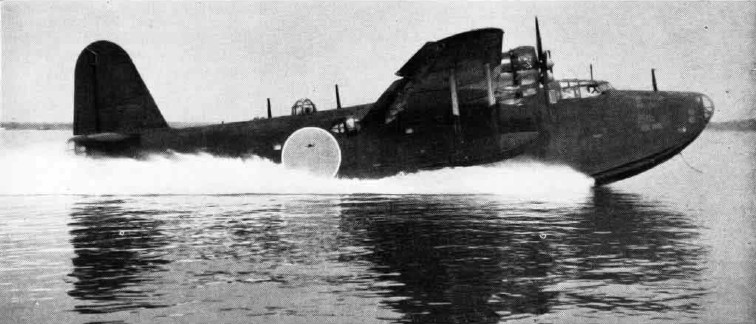
Main long-range four-engine flying boat, 167 built. By all account a Japanese Sunderland.
Nippi L7P1 (1942)
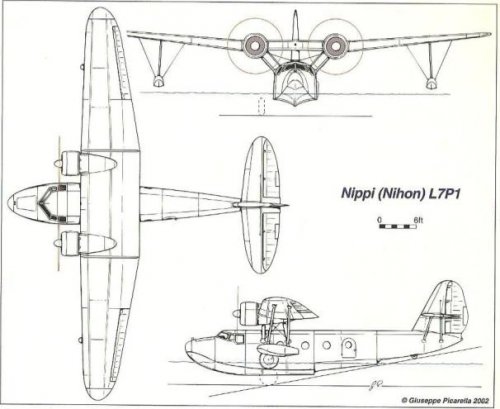
The Nippi L7P1 was an amphibian inspired by the Fairchild A942-B amphibian(LXF 1) and was called 13-shi light transport. These two were completed at Nippon Hikoki Kabushiki Kaisha in February 1942 and tested. They showed stall tendency due to the high load of their wooden main wing and difficult take off. Never ordered for production. It had two Nakajima Kotobuki 41, Air cooled 9 cylinder engines, 710hp. Wing span 19.6m, lenght 14.0m, height:4.7m. It weight 3,705kg/5,899kg. Top speed 332km/h (179.4kt) and Ceiling 7,100m, 6.0h autonomy.
Kawanishi N1K1 Kyofu "Rex" (1942)
The main IJN floatplane fighter variant of the land-based fighter Kawanishi N1K-J Shiden, of which 1,532 built.Aichi M6A1 Seiran (1943)
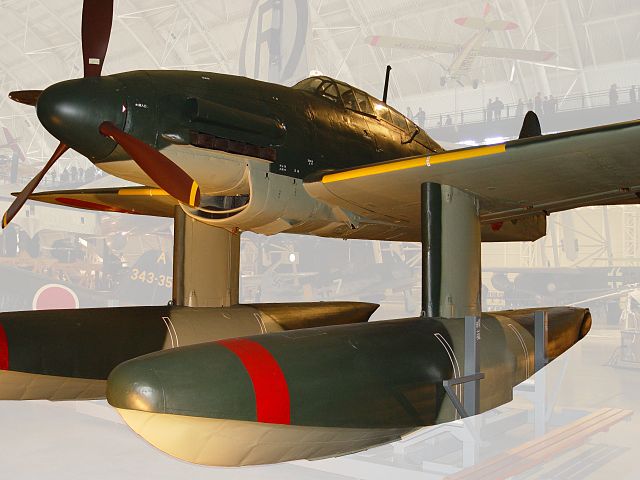
Navy Special Strike Submarine-based Bomber, developed for the I-400 submarines, 28 built.
Also Tested
-Aichi M6A1-K Nanzan Floatplane trainer Navy Special Strike Submarine Bomber trainer (1943, 2 built) -Kyushu Q1W1-K Tokai-Ren "Lorna", twin-engine Floatplane trainer of the NavyKawanishi KX-03 (1943)
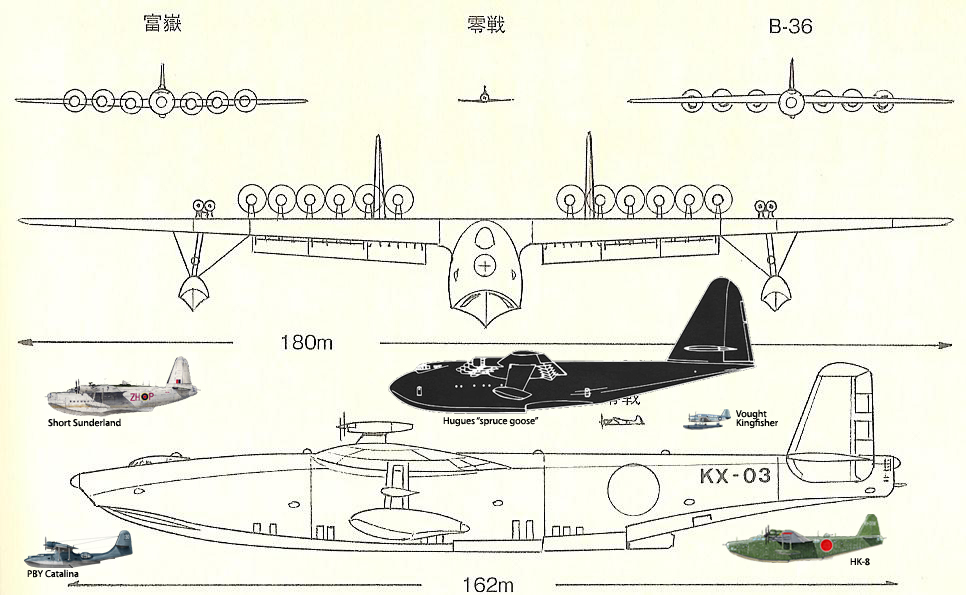
Weekly Project !
We will go into naval aircraft soon, and for a starter, what a better piece of virtual hardware than these Kawanishi reports No 541, 544 and 566 "500-ton class flying boat study" - better known around the net as the KX-03. The IJN ordered Kawanishi to study a (circa) 500 ton class flying boat, at the beginning of 1943.
Although records of discussions leading to this order were lost, we can guess what was the incentive:
In 1943, IJN naval losses started to mount due to USN submarines action, it would peak the next year and increasingly make supplying Japan or the Pacific garrisons a desperate gamble. The only way to avoid being targeted by a submarine was to be either be given a very shallow draft (like landings crafts were), too fast to be catch by subs (which was true for destroyers and TBs, often used to carry troops and supplies), or be a transport submarine (like the Yu class started in 1944), or ...stay above the waves. The concept of "wing-in-ground effect" was well-known already and many nations studied the possibilities of designing small crafts using this technique. The Austro-Hungarian Versurchsgleitsboote was the first of them, but the tech really started to mature from 1960.
This flying boat was massive, twice as large as any aircraft ever designed (heavier than air that is). To clear out any speculation here, none was built, and it stayed as a paper project, although the study was discontinued into 1944-45.
The Ne201 was still experimental, and was still not ready when the war ended in August 1945. By 1943 the existing Ne 10 and Ne 12 engines were never to be powerful enough for the task, and were still in development. By July 1944, the BMW 003A arrived via submarine in Japan, and became the basis for the Ne 20 and derivatives. By June 1945 it was still not ready for production either, only 6 preserie engines being still tested at the Mitsubishi factory. The Ne 330 was not developed further away.
It is possible that the KX-3 followed two earlier designs with only classic props, and the KX-3 won turbo-jets, with only a prototype, the Kawanishi K-200 just designed. The latter was close to prototyping, and featured six Ne-330 jet engines on its wings. This showed some similarity to the KX-3 project , basically a scaled-up version. This was a more reasonable design that could have been ready on time, but its Ne 330 engines were never ready, and in addition, range was poor. On the other hand, the IJN also took delivery of its largest operational fling boat, the Kawanishi H11K Soku, a 26.5 tons plane, with Four Mitsubishi MK4Q Kasei 22 (Ha·32-22) 14-cyl. AC radial engines for 1850 hp. It never became operational because of other priorities, and by March 1945, progresses stopped, Kawanishi being ordered to concentrate on the NI K2-J Shiden-Kai fighter instead. The only existing mock-up of the Soku was destroyed by an air raid in April 1945, off the Seto Inland Sea.
The H8K flying boat was used as the starting point for the design, dimensions just were stretched-up endlessly, reaching 531 feet long by 590 foot wingspan, and 116 feet in height. The engines were revolutionary, the Rikugun Kokugijutsu Kenkyuuju (RKK) Ne 201 turboprops being multiple-bladed and installed in a pusher configuration. This was completed by Ne 330 engines derived from the BMW engines in streamlined nacelles. It was hoped the accumulation was enough to carry out of the water the flying "ship". For self-defence, nose and tail would have been given a 20mm automatic cannon completed by several dorsal turrets along the dorsal fuselage spine, probably with trusted 13mm air-cooled heavy machine guns and in the fuselage side.
The size of this plane could have allowed to carry its own parasite self-defence fighters in a more elaborated, more powerful version.
But by 1944, the USN air superiority made this giant nothing more than a juicy target.
The height of the fuselage probably would have allowed for three full decks to carry troops and their equipments.
By late 1943, although it was submitted to the IJN, no fate is known for the project, albeit some clues showed it was discontinued until 1945, but doomed at that time by the lack of resources of all sorts and gasoline to start with, plus USN aviation clear superiority.
In any case, the KX-3 was the pinnacle of the wartime development for Kawanishi, which designed suicide rocket planes in the end. After the war, the company was reborn as Shin Meiwa Industries, providing the JSDMF the PS-1 and US-2.
Kawanishi KX03 known specs:
Overall length: 162 mWingspan: 180 m
Height: 35.4 m
Wing area: 1,150 square meter
Gross weight: 460 ton
Range: 18,520 km
Crew: 24
Payload: 900 soldiers fully equipped, possibly softskin vehicles.
Engines: -Twelve Ne201 turbo propellers engines (1,870 hp and a static thrust of 900kg per engine, total 132,000hp)
-Six Ne330 jet engine (7,920hp equivalent)
- Lohner E (1913)
- Macchi M3 (1916)
- Macchi M5 (1918)
- Ansaldo ISVA (1918)
- Sopwith Baby (1916)
- Short 184 (1916)
- Fairey Campania (1917)
- Sopwith Cuckoo (1917)
- Felixstowe F.2 (1917)
- Friedrichshafen FF 33 (1916)
- Albatros W4 (1916)
- Albatros W8 (1918)
- Hanriot HD.2
- Grigorovitch M5
- IJN Farman MF.7
- IJN Yokosho Type Mo
- Yokosho Rogou Kougata (1917)
- Yokosuka Igo-Ko (1920)
- Curtiss N9 (1916)
- Aeromarine 39
- Vought VE-7
- Douglas DT (1921)
- Boeing FB.5 (1923)
- Boeing F4B (1928)
- Vought O2U/O3U Corsair (1928)
- Blackburn Blackburn (1922)
- Supermarine Seagull (1922)
- Blackburn Ripon (1926)
- Fairey IIIF (1927)
- Fairey Seal (1930)
- LGL-32 C.1 (1927)
- Caspar U1 (1921)
- Dornier Do J Wal (1922)
- Rohrbach R-III (1924)
- Mitsubishi 1MF (1923)
- Mitsubishi B1M (1923)
- Yokosuka E1Y (1923)
- Nakajima A1N (1927)
- Nakajima E2N (1927)
- Mitsubishi B2M (1927)
- Nakajima A4N (1929)
- CANT 18
WW1
✠ K.u.K. Seefliegerkorps:
 Italian Naval Aviation
Italian Naval Aviation
 RNAS
RNAS
 Marineflieger
Marineflieger
 French Naval Aviation
French Naval Aviation
 Russian Naval Aviation
Russian Naval Aviation
 IJN Air Service
IJN Air Service
 USA
USA
Interwar
 Interwar US
Interwar US
 Interwar Britain
Interwar Britain
 Interwar France
Interwar France
 Interwar Germany
Interwar Germany
 Interwar Japan
Interwar Japan
 Interwar Italy
Interwar Italy
- Curtiss SOC seagull (1934)
- Grumman FF (1931)
- Curtiss F11C Goshawk (1932)
- Grumman F2F (1933)
- Grumman F3F (1935)
- Northrop BT-1 (1935)
- Grumman J2F Duck (1936)
- Consolidated PBY Catalina (1935)
- Brewster/NAF SBN-1 (1936)
- Curtiss SBC Helldiver (1936)
- Vought SB2U Vindicator (1936)
- Brewster F2A Buffalo (1937)
- Douglas TBD Devastator (1937)
- Vought Kingfisher (1938)
- Curtiss SO3C Seamew (1939)
- Douglas SBD Dauntless (1939)
- Grumman F4F Wildcat (1940)
- F4U Corsair (NE) (1940)
- Brewster SB2A Buccaneer (1941)
- Grumman TBF/TBM Avenger (1941)
- Consolidated TBY Sea Wolf (1941)
- Grumman F6F Hellcat (1942)
- Curtiss SB2C Helldiver (1942)
- Curtiss SC Seahawk (1944)
- Grumman F8F Bearcat (1944)
- Ryan FR-1 Fireball (1944)
- Douglas AD-1 Skyraider (1945)
Fleet Air Arm
- Fairey Swordfish (1934)
- Blackburn Shark (1934)
- Supermarine Walrus (1936)
- Fairey Seafox (1936)
- Blackburn Skua (1937)
- Short Sunderland (1937)
- Blackburn Roc (1938)
- Fairey Albacore (1940)
- Fairey Fulmar (1940)
- Grumman Martlet (1941)
- Hawker sea Hurricane (1941)
- Brewster Bermuda (1942)
- Fairey Barracuda (1943)
- Fairey Firefly (1943)
- Grumman Tarpon (1943)
- Grumman Gannet (1943)
- Supermarine seafire (1943)
- Blackburn Firebrand (1944)
- Hawker Sea Fury (1944)
IJN aviation
- Aichi D1A "Susie" (1934)
- Mitsubishi A5M "Claude" (1935)
- Nakajima A4N (1935)
- Yokosuka B4Y "Jean" (1935)
- Mitsubishi G3M "Nell" (1935)
- Nakajima E8N "Dave" (1935)
- Kawanishi E7K "Alf" (1935)
- Nakajima B5N "Kate" (1937)
- Kawanishi H6K "Mavis" (1938)
- Aichi D3A "Val" (1940)
- Mitsubishi A6M "zeke" (1940)
- Nakajima E14Y "Glen" (1941)
- Nakajima B6N "Jill" (1941)
- Mitsubishi F1M "pete" (1941)
- Aichi E13A Reisu "Jake" (1941)
- Kawanishi E15K Shiun "Norm" (1941)
- Nakajima C6N Saiun "Myrt" (1942)
- Yokosuka D4Y "Judy" (1942)
- Kyushu Q1W Tokai "Lorna" (1944)
Luftwaffe
- Arado 196 (1937)
- Me109 T (1938)
- Blohm & Voss 138 Seedrache (1940)
Italian Aviation
- Savoia-Marchetti S.55
- IMAM Ro.43/44
- CANT Z.501 Gabbiano
- CANT Z.506 Airone
- CANT Z.508
- CANT Z.511
French Aeronavale
- GL.300 (1926-39)
- Levasseur PL.5 (1927)
- Potez 452 (1935)
- Loire 210 (1936)
- Loire 130 (1937)
- LN 401 (1938)
Soviet Naval Aviation
- Shavrov SH-2 (1928)
- Tupolev TB-1P (1931)
- Beriev MBR-2 (1930)
- Tupolev MR-6 (1933)
- Tupolev MTB-1 (1934)
- Beriev Be-2 (1936)
- Polikarpov I16 naval (1936)
- Tupolev MTB-2 (1937)
- Ilyushine DB-3T/TP (1937)
- Beriev Be-4 (1940)
-
Skoda Š-328V
R-XIII Idro
Fokker C.XI W (1934)
WW2
- De Havilland Sea Vixen
- Hawker Sea Hawk
- Supermarine Scimitar
- Blackburn Buccaneer
- Hawker Sea Harrier
- Douglas A4 Skyhawk
- Grumman F9F Panther
- Vought F8 Crusader
- McDonnell-Douglas F-4 Phantom-II
- North Am. A5 Vigilante
- TU-142
- Yak 38 forger
☢ Cold War
✧ NATO
 Fleet Air Arm
Fleet Air Arm
 US Navy
US Navy
☭ Warsaw Pact
Merch

Seafire Mark 45; HMS Pretoria Castle

Zeros vs its aversaries

Aichi D3A “Val” Junyo

Mitsubishi A5M poster

F4F wildcat

Macchi M5

SBD Dauntless Coral Sea

SBD Dauntless USS Enterprise

SBD-4 CV22